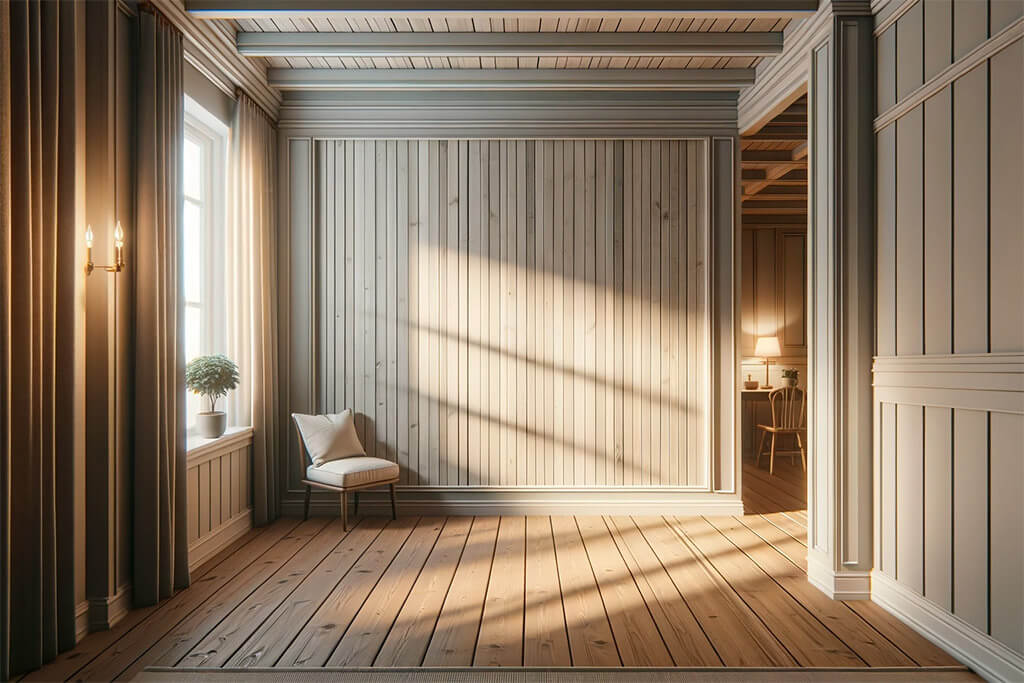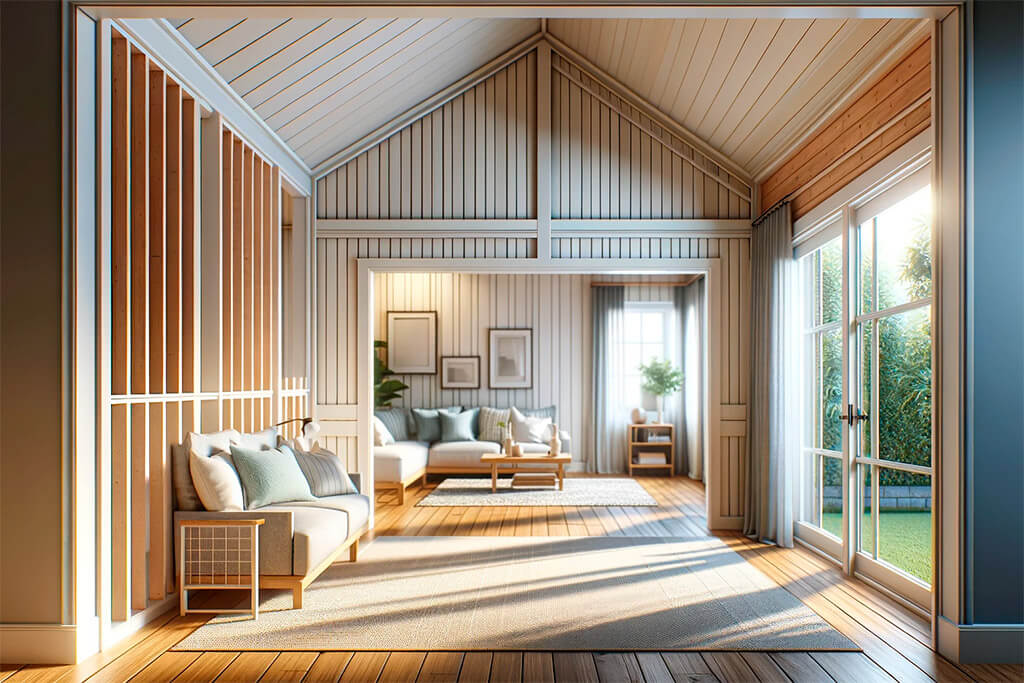Board and batten walls have a rich heritage, tracing back to the days when functionality dictated design. These walls, originally used for their structural robustness on exteriors, have evolved into a popular interior design choice. What makes them so appealing is their simplicity and versatility. Whether you’re aiming for a cozy cottage feel or a crisp, modern look, board and batten can deliver. It’s a style that appeals to a broad spectrum, from DIY novices taking on their first project to seasoned builders looking for a classic touch.

Understanding Board and Batten Walls
The concept of board and batten is straightforward: wide boards are mounted on the wall, with narrower strips, or battens, covering the seams. This creates a pleasing geometric pattern that adds depth and texture to any room. The choice of materials can range from traditional solid wood, which offers warmth and a timeless look, to engineered products like MDF, which are budget-friendly and offer a smooth finish for painting. For exterior applications, vinyl is a durable and maintenance-free option. The beauty of this design lies in its adaptability – you can mix and match board widths or batten styles to suit your personal taste or to fit the architectural style of your home.
Tools and Materials
A successful board and batten project hinges on having the right tools and materials at hand. Here’s what you’ll need:
Tools:
- Tape Measure: Precision is crucial for a polished look.
- Level: Essential for ensuring straight, even lines.
- Saw: A miter saw is ideal for accurate cuts, but a circular saw or hand saw can also work.
- Nail Gun or Hammer: A nail gun can speed up the process, but a hammer is just as effective.
- Caulk Gun: For a seamless finish.
- Sander or Sandpaper: Important for prepping your boards for painting or staining.
Materials:
- Boards and Battens: Choose materials that suit your project’s needs – each has its pros and cons.
- Fasteners: Nails or screws should be suitable for the material of your boards and your wall.
- Caulk or Wood Filler: To fill gaps and give your wall a finished look.
- Primer and Paint or Stain: Depending on the desired finish.
Measurement and Planning:
- Draw a Detailed Plan: Sketch out your design, including the pattern and spacing.
- Calculate Material Needs: Ensure you have enough boards and battens, factoring in cuts and potential waste.
- Room Specifics: Consider the placement of electrical outlets, switches, and architectural features.
Taking the time to plan and prepare makes the installation process smoother and ensures a professional-looking result. Board and batten is a classic design element that, when executed well, adds character and dimension to any space. With careful planning and attention to detail, you can create a feature that enhances the aesthetic and feel of your home.

Step-by-Step Guide to Installation
Preparing the Wall: Before anything else, proper wall preparation is crucial. This involves more than just a simple clean-up. If dealing with existing paint or wallpaper, you need to remove it completely. Use a scraper or putty knife to get rid of old layers, fill any holes or cracks with spackle, and sand the surface to ensure it’s smooth and even. An uneven wall can lead to problems with your board and batten alignment, so take your time with this step.
Measuring and Planning: Accurate measurements are key to a successful board and batten installation. Measure your wall carefully and plan your layout. This is not a one-size-fits-all approach – the layout should be customized to the wall’s dimensions. Use tools like a chalk line or a laser level to mark the placement of your battens. The goal is to achieve a visually balanced layout that complements the room’s size and shape.
Cutting and Fitting Boards: When it comes to cutting your boards, accuracy is paramount. Always follow the adage: measure twice, cut once. A miter saw is ideal for making precise cuts. Before you fix the boards in place, do a dry fit to ensure everything aligns correctly. Pay special attention to the fit around outlets and other fixtures on your wall.
Securing Battens: The proper installation of battens is what will make your board and batten wall stand out. Whether using a nail gun for efficiency or a hammer for a more traditional approach, ensure your battens are securely attached and flush against the wall. They should be straight and well-aligned, as they form the defining feature of your design.
Finishing Touches: The final steps of caulking and painting can dramatically affect the overall look of your board and batten wall. Caulk should be applied neatly to seal the seams, followed by sanding any rough areas. When painting, apply a smooth, even coat to enhance the texture and pattern of the boards and battens. If staining, take your time to achieve a consistent finish.

Customization and Creative Ideas
Incorporating Different Widths and Patterns: The beauty of board and batten is in its versatility. Experimenting with different board widths can create unique and eye-catching patterns. Consider trying various layouts such as horizontal, vertical, or even diagonal arrangements to suit the style of your room.
Color Schemes: The color choice for your board and batten wall should complement the overall design of your room. Whether opting for soft, neutral tones for a calming effect or bold colors for a statement piece, the right color can significantly enhance the visual appeal of your wall.
Unique Installations: Every installation can be a reflection of your personal style. From achieving a rustic look with weathered wood to creating a sleek, contemporary feel with glossy finishes, the possibilities are endless. Each room can have its distinct character, dictated by the board and batten wall design.
Maintenance and Care
Routine Cleaning and Upkeep: Regular maintenance is key to preserving the appearance of your board and batten wall. Dusting and occasional gentle cleaning with a mild detergent can keep it looking fresh. Be cautious with the amount of water and pressure used, especially on painted surfaces.
Repairing Common Issues: For minor scratches and dents, a bit of wood filler and touch-up paint or stain can effectively restore the wall’s appearance. In the case of moisture damage, particularly in areas like bathrooms, ensure that any underlying issues such as inadequate ventilation are addressed.
Long-term Care: Different materials used in board and batten walls require different care approaches. Wood may need periodic repainting or restaining, while MDF should be kept dry and regularly dusted. Regular inspections and minor touch-ups can help maintain the wall’s aesthetic appeal and structural integrity over time.

Common Mistakes to Avoid
Overlooking Wall Imperfections: In my years of experience, I’ve learned that preparation is as crucial as the installation itself. A common pitfall is neglecting wall imperfections. Prior to installation, scrutinize your wall for any irregularities. Holes, cracks, and even minor dents should be addressed. Filling and sanding these imperfections are essential steps to ensure a flawless finish for your board and batten walls.
Incorrect Measurement and Cutting Techniques: Another area where many falter is in measurement and cutting. A rule of thumb that has served me well is the age-old adage: “Measure twice, cut once.” Precision in this stage is non-negotiable. Inaccuracies here can lead to unsightly gaps and misaligned battens, detracting from the overall appearance. Invest in a good-quality tape measure and a reliable saw. Remember, accuracy in your cuts will reflect in the quality of your finished project.
Inadequate Sealing and Finishing: Finally, do not underestimate the importance of proper sealing and finishing. This step is not just about aesthetic appeal, it plays a pivotal role in the durability of your installation. Quality caulking and meticulous painting or staining will protect your wall from moisture and everyday wear. This step is about protecting your investment and ensuring the longevity of your work.
FAQ Section
Selecting the right wood is crucial for the success of your project. Consider factors like durability, aesthetics, and cost. For exterior applications, woods like cedar and redwood offer natural resistance to rot and insects. For interior use, options like pine or MDF are cost-effective and provide a smooth finish for painting.
Yes, but it’s vital to account for the high moisture environment. Opt for materials that are moisture-resistant, such as PVC or treated wood. Additionally, ensure good ventilation in the bathroom to prevent issues like mold and mildew.
Modernizing a board and batten wall can be achieved by experimenting with the widths of boards and battens and exploring different color schemes. Narrow battens can create a sleek, contemporary look, while a mix of wide and narrow boards can add an interesting visual dynamic. Colors like crisp whites or cool grays can lend a modern feel to your space.
Board and batten can be an excellent choice for exterior walls, provided you use the right materials. Look for exterior-grade woods, vinyl, or composite materials that are designed to withstand weather conditions. Proper sealing and finishing are essential to protect the material from the elements and ensure durability.
